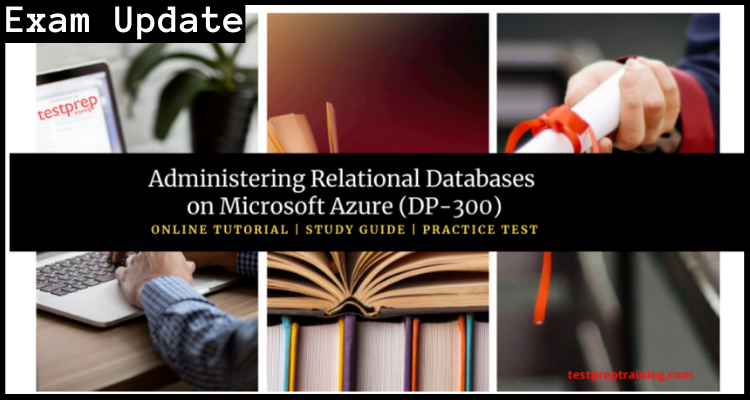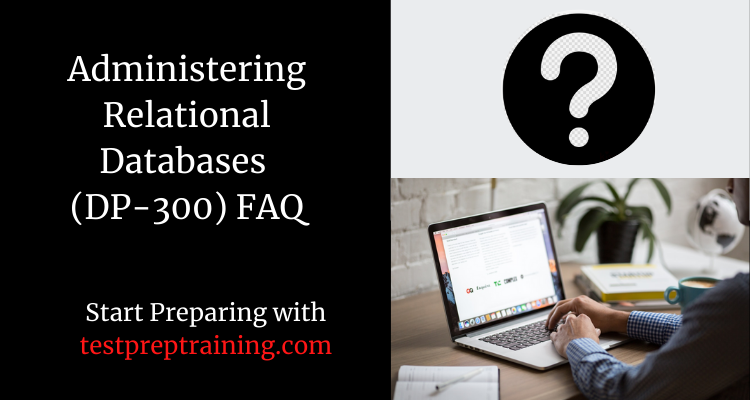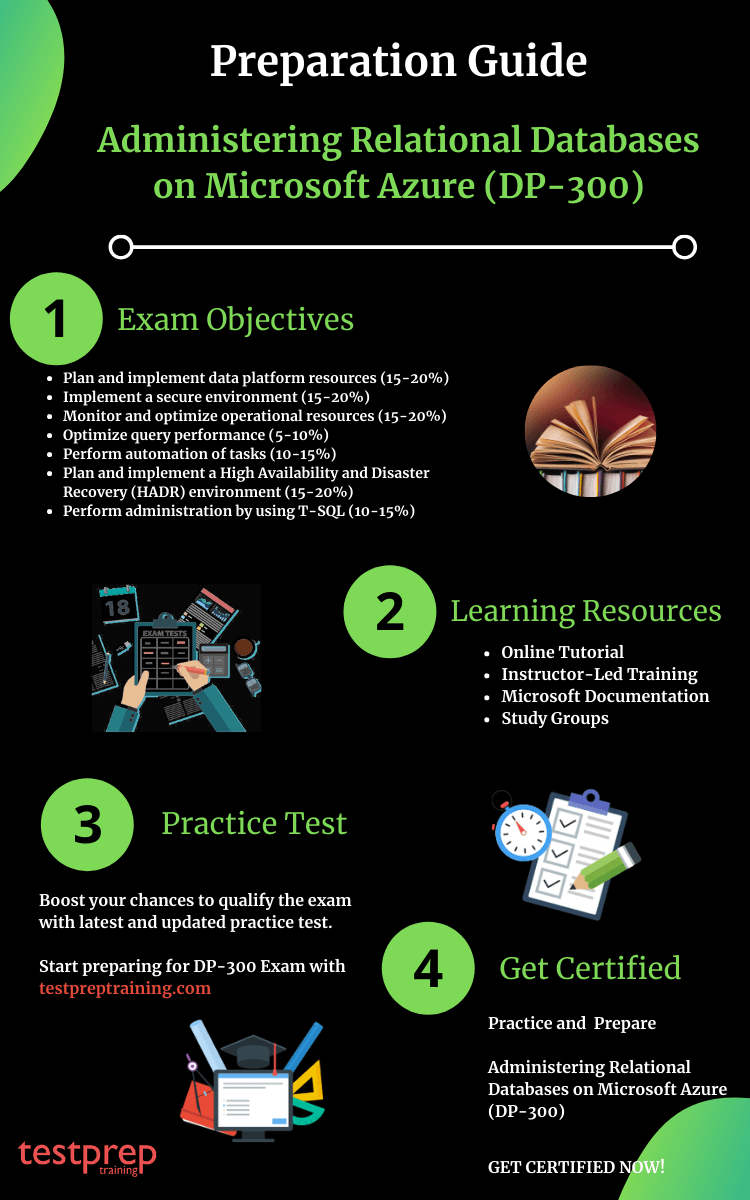Exam DP-300: Administering Relational Databases on Microsoft Azure

Administering Relational Databases on Microsoft Azure (DP-300) Exam has been built to measure your ability to perform tasks including
- Planning and implementing data platform resources
- Implementing a secure environment
- Monitoring and optimizing operational resources
- Optimizing query performance
- Perform automation of tasks
- Planning and implementing a High Availability and Disaster Recovery (HADR) environment
- Performing administration by using T-SQL.
Who should take this exam?
The Administering Relational Databases on Microsoft Azure DP-300 Exam is suitable for candidates working as database administrators and data management specialists responsible for managing on-premises and cloud relational databases built with Microsoft SQL Server and Microsoft Azure Data Services.
Roles and Responsibilities
As an Azure Database Administrator, you will be required to
- Implement and manage the operational aspects of cloud-native and hybrid data platform solutions built on Azure Data Services and SQL Server.
- Use a variety of methods and tools for performing day-to-day operations.
- Manage availability, security and performance monitoring and optimization of modern relational database solutions.
This role works with the Azure Data Engineer role to manage operational aspects of data platform solutions
Looking for DP-300: Administering Relational Databases on Microsoft Azure interview preparation, click here now!
Learning Path
Microsoft provides applicants with a learning path that guides them through the ideas in a step-by-step manner. The Microsoft Azure DP-300 test study routes, on the other hand, feature modules that assist candidates in improving their skills and knowledge.

Exam Format
| Exam Name Administering Relational Databases on Microsoft Azure | Exam Code DP-300 |
| Exam Duration 150 mins | Exam Format Multiple Choice and Multi-Response Questions |
| Exam Type Cloud Computing | Number of Questions 40-60 Questions |
| Eligibility/Pre-Requisite NIL | Exam Fee $165 USD |
| Exam Language English, Chinese (Simplified), Japanese, Korean | Pass Score 700 (on a scale of 1-1000) |
Exam Policies
Exam policies are provided by Microsoft to assist applicants in planning and managing a favorable outcome. Microsoft Certification exam policies allow applicants access to all exam-related facts, including the processes for taking the exam and recovering from it. These exam policies consist of a set of guidelines that must be observed throughout the exam or at the testing location.
Exam DP-300: Administering Relational Databases on Microsoft Azure FAQ
Get all your doubts resolved, for more details visit Administering Relational Databases on Microsoft Azure (DP-300) FAQ

Course Outline
The Administering Relational Databases on Microsoft Azure (DP-300) Exam covers the following topics –
The updated Microsoft DP-300 exam topics include:
1. Plan and Implement Data Platform Resources (20-25%)
Plan and deploy Azure SQL solutions
- Deploy database offerings on selected platforms ( Microsoft Documentation: Create an Azure SQL Database single database)
- Understand automated deployment
- Apply patches and updates for hybrid and infrastructure as a service (IaaS) deployment
- Deploy hybrid SQL Server solutions
- Recommend an appropriate database offering based on specific requirements
- Evaluate the security aspects of the possible database offering
- Recommend a table partitioning solution
- Recommend a database sharding solution
Configure resources for scale and performance
- Configure Azure SQL Database for scale and performance
- Configure Azure SQL Managed Instance for scale and performance
- Configure SQL Server on Azure Virtual Machines for scale and performance
- Configure table partitioning
- Configure data compression
Plan and implement a migration strategy
- Evaluate requirements for the migration ( Microsoft Documentation: Azure Database Migration Service)
- Evaluate offline or online migration strategies
- Implement an online migration strategy ( Microsoft Documentation: Migrate SQL Server to a single database or pooled database in Azure SQL Database online using DMS)
- Implement an offline migration strategy ( Microsoft Documentation: Migrate SQL Server to Azure SQL Database offline using DMS)
- Perform post migration validations
- Troubleshoot a migration
- Set up SQL Data Sync for Azure
- Implement a migration to Azure
- Implement a migration between Azure SQL services
- Implement Azure SQL Managed Instance database copy and move
2. Implement a Secure Environment (15-20%)
Configure database authentication and authorization
- Configure authentication by using Active Directory and Microsoft Entra ID
- Create users from Microsoft Entra identities
- Configure security principals
- Configure database and object-level permissions using graphical tools
- Apply principle of least privilege for all securables
- Troubleshoot authentication and authorization issues
- Manage authentication and authorization by using T-SQL
Implement security for data at rest and data in transit
- Implement Transparent Data Encryption (TDE) ( Microsoft Documentation: Transparent data encryption for SQL Database, SQL Managed Instance, and Azure Synapse Analytics)
- Implement object-level encryption ( Microsoft Documentation: Configure Always Encrypted by using Azure Key Vault)
- Configure server and database-level firewall rules ( Microsoft Documentation: Server-level versus database-level IP firewall rules, Create a server-level firewall rule using the Azure portal)
- Implement Always Encrypted ( Microsoft Documentation: Configure Always Encrypted by using the Windows certificate store)
- Implement Always Encrypted with VBS enclaves
- Configure secure access
- Configure Transport Layer Security (TLS)
Implement compliance controls for sensitive data
- Apply a data classification strategy ( Microsoft Documentation: Data classification)
- Configure server and database audits ( Microsoft Documentation: Auditing for Azure SQL Database and Azure Synapse Analytics)
- Implement data change tracking ( Microsoft Documentation: Enable and Disable Change Tracking (SQL Server))
- Implement dynamic data masking
- Manage database resources by using Azure Purview
- Implement database ledger in Azure SQL
- Implement row-level security
- Configure Microsoft Defender for SQL
3. Monitor, configure, and optimize database resources (20–25%)
Monitor resource activity and performance
- Prepare an operational performance baseline ( Microsoft Documentation: Establish a Performance Baseline)
- Determine sources for performance metrics ( Microsoft Documentation: Sources of monitoring data for Azure Monitor)
- Interpret performance metrics ( Microsoft Documentation: Monitoring and performance tuning in Azure SQL Database and Azure SQL Managed Instance, Query Performance Insight for Azure SQL Database)
- Configure and monitor activity and performance
- Monitor by using SQL Insights
- Monitor by using Extended Events
Monitor and optimize query performance
- Configure Query Store ( Microsoft Documentation: Query Performance Insight for Azure SQL Database)
- Monitor by using Query Store
- Identify sessions that cause blocking
- Identify performance issues using dynamic management views (DMVs)
- Identify and implement index changes for queries
- Recommend query construct modifications based on resource usage
- Assess the use of query hints for query performance
- Review execution plans
- Monitor by using Intelligent Insights
Configure database solutions for optimal performance
- Implement index maintenance tasks
- Implement statistics maintenance tasks
- Implement database integrity checks
- Configure database automatic tuning
- Configure server settings for performance
- Configure Resource Governor for performance
- Implement database-scoped configuration ( Microsoft Documentation: ALTER DATABASE SCOPED CONFIGURATION (Transact-SQL))
- Configure compute and storage resources for scaling ( Microsoft Documentation: Manage compute for dedicated SQL pool (formerly SQL DW) in Azure Synapse Analytics)
- Configure intelligent query processing (IQP) ( Microsoft Documentation: Intelligent query processing in SQL databases)
4. Configure and manage automation of tasks (15–20%)
Create and manage SQL Server Agent jobs
- Manage schedules for regular maintenance jobs ( Microsoft Documentation: Automate management tasks using database jobs)
- Configure job alerts and notifications
- Troubleshoot SQL Server Agent jobs
Automate deployment of database resources
- Automate deployment by using Azure Resource Manager templates (ARM templates) and Bicep
- Automate deployment by using PowerShell
- Automate deployment by using Azure CLI
- Monitor and troubleshoot deployments
Create and manage database tasks in Azure
- Create and configure elastic jobs
- Create and configure database tasks by using automation
- Configure alerts and notifications on database tasks
- Troubleshoot automated database tasks
5. Plan and configure a high availability and disaster recovery (HA/DR) environment (20–25%)
Recommend an HADR strategy for a database solution
- Recommend HA/DR strategy based on Recovery Point Objective/Recovery Time Objective (RPO/RTO) requirements
- Evaluate HADR for hybrid deployments ( Microsoft Documentation: Hybrid IT: Disaster recovery solutions)
- Evaluate Azure-specific HADR solutions ( Microsoft Documentation: Azure only: Disaster recovery solutions)
- Recommend a testing procedure for an HA/DR solution
Plan and perform backup and restore of a database
- Recommend a database backup and restore strategy
- Perform a database backup by using database tools
- Perform a database restore by using database tools
- Perform a database restore to a point in time ( Microsoft Documentation: Restore a SQL Server Database to a Point in Time (Full Recovery Model))
- Configure long-term backup retention ( Microsoft Documentation: Manage Azure SQL Database long-term backup retention)
- Backup and restore a database by using T-SQL
- Backup and restore to and from cloud storage
Configure HA/DR for database solutions
- Configure active geo-replication
- Configure an Always On availability group ( Microsoft Documentation: Manually configure an availability group (SQL Server on Azure VMs))
- Configure auto-failover groups
- Configure quorum options for a Windows Server Failover Cluster
- Configure Always On Failover Cluster Instances on Azure virtual machines
- Configure log shipping
- Monitor an HA/DR solution
- Troubleshoot an HA/DR solution
Preparation Guide for Administering Relational Databases on Microsoft Azure (DP-300)
Indeed it is very important to have the right resources in hand before you start your preparation. For every individual their different ways to go plan out their preparation. So before you set up your timetable and plan for preparation check out some of the most essential learning resources that you must refer to before the final exam. Let’s begin with the DP-300 exam study guide to help you plan better.

1. Microsoft Learning Platform
The first and foremost learning resource that will be beneficial during the exam preparation is the Microsoft learning platform. However, make sure to go through the official website before that. For the Microsoft Azure DP-300 exam, it would be best to first go through the Microsoft official website to get authentic information about the exam. Gather all the related information including the course outline, prerequisites, knowledge required and skills acquired. The official DP-300 exam topics cover –
- Plan and implement data platform resources (15-20%)
- Implement a secure environment (15-20%)
- Monitor and optimize operational resources (15-20%)
- Optimize query performance (5-10%)
- Perform automation of tasks (10-15%)
- Plan and implement a High Availability and Disaster Recovery (HADR) environment (15-20%)
- Perform administration by using T-SQL (10-15%)
2. Microsoft Documentation
We also have the Microsoft documentation which elaborates at length the Fundamentals exam concepts using the learning guide that cover various modules. These Microsoft Docs lessons will help you learn a lot about Azure data principles and the many services available inside it. The following are some of the learning concepts:
- Azure SQL Fundamentals
- Plan and implement data platform resources
- Implement a secure environment for a database service
- Monitor and optimize operational resources in SQL Server
- Optimize query performance in SQL Server
3. Instructor-led Training
Candidates with the expertise and abilities to operate a SQL Server database infrastructure for cloud, on-premises, and hybrid relational databases and who work with the Microsoft PaaS relational database services can take an instructor-led course offered by Microsoft. Individuals who design apps that distribute content from SQL-based relational databases can also benefit from this Microsoft DP-300 course.
Microsoft Instructor Led-Training Microsoft Azure DP-300 Exam
4. Online Study Groups
Joining study groups is another important resource that may be quite valuable during test preparation. As these organizations will assist you in staying connected with those who are on a similar route as you. Furthermore, you may start a debate about any exam-related concern or query here. You will receive the best possible response to your inquiry if you do so.
5. Evaluate yourself with Practice Tests
This is one of the most important components that will assist you in better preparing for the exam. The Microsoft DP-300 practice exams are useful not only for assessing yourself but also for identifying your weak areas that need to be addressed. However, by practicing, you will be able to enhance your replying abilities, allowing you to save a significant amount of time. Furthermore, the optimum time to begin practicing exams is after you have completed one whole topic since this will serve as a revision tool for you. As a result, be sure to look for the best practice resources.

